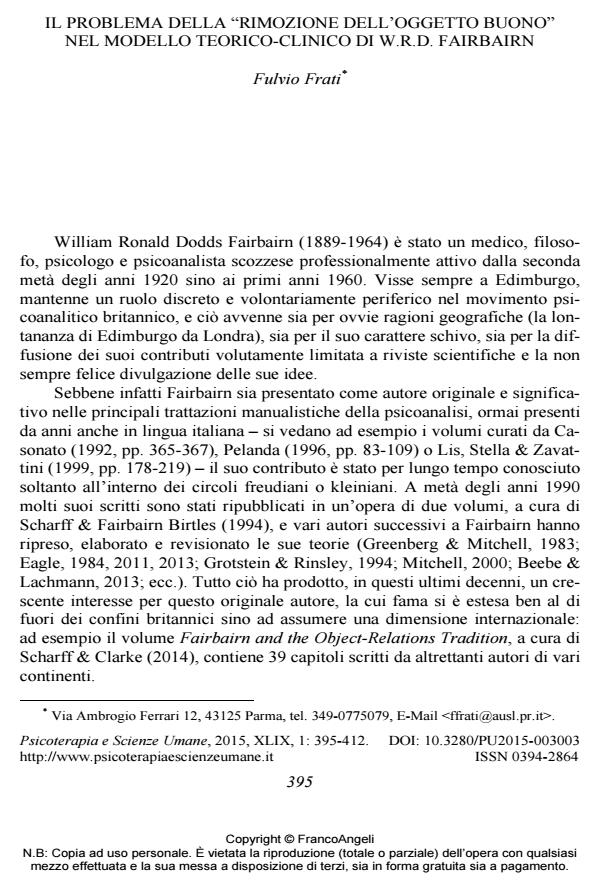The problem of "repression of the good object" in W.R.D. Fairbairn’s theoretical model
Journal title PSICOTERAPIA E SCIENZE UMANE
Author/s Fulvio Frati
Publishing Year 2015 Issue 2015/3
Language Italian Pages 18 P. 395-412 File size 149 KB
DOI 10.3280/PU2015-003003
DOI is like a bar code for intellectual property: to have more infomation
click here
Below, you can see the article first page
If you want to buy this article in PDF format, you can do it, following the instructions to buy download credits

FrancoAngeli is member of Publishers International Linking Association, Inc (PILA), a not-for-profit association which run the CrossRef service enabling links to and from online scholarly content.
In contemporary psychoanalysis there is a general agreement on the idea that representations of "bad objects" are often kept unconscious through the mechanism of repression. However, the Scottish psychoanalyst William Ronald Dodds Fairbairn (1889-1964) suggested, counter-intuitively, that also the "good object" can be repressed. This aspect is discussed within Fairbairn’s overall metapsychology, and an attempt is made in order to understand why also a good or ideal object can undergo repression. In the discussion, a reference to Ignacio Matte Blanco’s 1975 theory of the bi-logic of the "unconscious as infinite sets" is made. Clinical implications and the contributions of other authors (such as David P. Celani, David E. Scharff, and Neil J. Skolnick) are also examined.
Keywords: W.R.D. Fairbairn, good object, psychoanalytic metapsychology, object relations, repression
- Il conflitto intrapsichico e l'evoluzione storica del suo approccio psicoterapeutico in psicoanalisi Fulvio Frati, in Ricerca Psicoanalitica /2021
DOI: 10.4081/rp.2021.535 - Humanity in Psychology Giulia Savarese, Nadia Pecoraro, Oreste Fasano, Monica Mollo, Luna Carpinelli, pp.225 (ISBN:978-3-031-30639-6)
- Dalla ‘mente isolata’ al ‘volo degli storni’ Fulvio Frati, in Ricerca Psicoanalitica /2022
DOI: 10.4081/rp.2022.648
Fulvio Frati, Il problema della "rimozione dell’oggetto buono" nel modello teorico-clinico di W.R.D. fairbairn in "PSICOTERAPIA E SCIENZE UMANE" 3/2015, pp 395-412, DOI: 10.3280/PU2015-003003